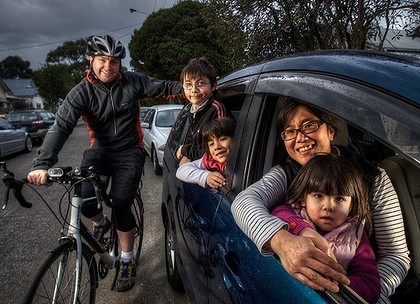
DAMIAN Walsh is convinced of the financial windfall that cycling to work provides; it has helped pay for his home renovation and will pay his son's private school fees.
While Mr Walsh, a Collins Street lawyer, cycles to work from Brunswick, his wife, Junko Kobayashi, uses the family car for errands and school drop-offs. They have been a one-car household since 1997.
Mr Walsh said the money they have saved has helped pay for a $450,000 energy-efficient renovation to their home.
''Car insurance alone would cost us $1000 a year,'' he said.
Figures out today in Bicycle Victoria's Ride On magazine will tell its 45,000 members that ditching one family car and riding a bicycle to work instead can be worth up to $3.5 million over a family's working lives.
Ride Oneditor Stephen Huntley said the magazine wanted to be as generous as it could to cars to deflect any allegation of bias, but the figures still showed savings of more than $800 a month.
In crunching the numbers, it assumed a good bicycle could last 10 years and when servicing and cycling gear were included, the annual cost was $1000 a year to commute by bicycle.
Basing its analysis on figures in the July edition of RACV magazine RoyalAuto and from the British RAC, Ride On estimated that a new medium-size car costs $10,660 to run and a used one, $8100. It also included $12 a day for city parking in its calculations.
The figures showed that if a 45-year-old ditched a car for a bicycle and saved the money into an account with 6 per cent interest, the person would save $358,000 by retirement age. For a person aged 25, the saving would be $1.04 million.
If a 45-year-old earned $60,000 a year and salary sacrificed the savings into superannuation, it would give them an extra $667,490 to retire on, the magazine said. A diligent 25-year-old would have an extra $3.5 million.
Mr Huntley said the figures seemed ''ridiculous'' but had been verified by superannuation company CareSuper and the Australian Securities and Investment Commission's online calculators. He said the article was important for cycling.
''A lot of people around the world talk about the financial benefit of giving up a second car, but we wanted to take it a step further and find out exactly how much that saving was,'' Mr Huntley said.
''The yearly figures are impressive enough, but, when you calculate them over a longer period, the figures are astounding. A lot of families say they cannot give up a car, which is fair enough, but we hope the figures provide an incentive for people to look at giving up a second car seriously.''
Mr Huntley said some families might find the savings were even greater than Ride On's estimates or that they did not need a car at all.
The Walsh-Kobayashi family still believe they need one family car. Ms Kobayashi uses the car for shopping and drives their son Declan to Xavier College, their daughter Grace to St Margaret Mary Primary School in Brunswick and their youngest, Gabbi, to kindergarten. On Saturdays the car is used to take the oldest children to Japanese classes in Oakleigh.
''You need a car when you have a family, there is no way Declan could get to school and they could not go to Japanese school if we didn't have one, but there is also no way we need a second car - it is too expensive,'' Ms Kobayashi said.
Mr Walsh said the savings were not his main motivation.
''I cycle just because I enjoy it, but also on the tram or in the car it is down time, wasted time,'' he said. ''It is far more efficient to use the time to exercise. If I didn't ride I would need to get exercise somewhere else and, with a young family, it is a really efficient way to get some exercise in.''
RACV manager of vehicle engineering Michael Case said there were many variables in the cost of running a car.
He said RACV would also encourage drivers to assess how many cars they really needed.
''Often a bicycle just won't be enough, but for some people a bicycle might be the right choice,'' he said.
